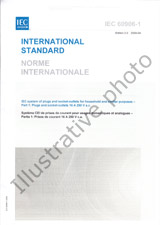We need your consent to use the individual data so that you can see information about your interests, among other things. Click "OK" to give your consent.

IEC 61156-11-ed.2.1+Amd.1-CSV
Multicore and symmetrical pair/quad cables for digital communications - Part 11: Symmetrical single pair cables with transmission characteristics up to 1,25 GHz - Horizontal floor wiring - Sectional specification
Translate name
STANDARD published on 12.6.2025
The information about the standard:
Designation standards: IEC 61156-11-ed.2.1+Amd.1-CSV
Publication date standards: 12.6.2025
SKU: NS-1223138
The number of pages: 54
Approximate weight : 162 g (0.36 lbs)
Country: International technical standard
Category: Technical standards IEC
The category - similar standards:
Annotation of standard text IEC 61156-11-ed.2.1+Amd.1-CSV :
IEC 61156-11:2023+AMD1:2025 CSV describes cables intended to be used for single balanced pair (office, home, industrial) applications according to ISO/IEC 11801-1. An example of existing application is 1000BASE-T1, see ISO/IEC TR 11801-9906. The transmission characteristics of these cables are specified up to a frequency of 1,25 GHz and at a temperature of 20 °C. The T1-C type cable is specified up to 600 MHz, the T1-D type cable up to 1,25 GHz. Depending on the MICE environment and the installation conditions either unscreened or screened cables can be used. A blank detail specification can be found in Annex A.
We recommend:
Technical standards updating
Do you want to make sure you use only the valid technical standards?
We can offer you a solution which will provide you a monthly overview concerning the updating of standards which you use.
Would you like to know more? Look at this page.



 Cookies
Cookies
